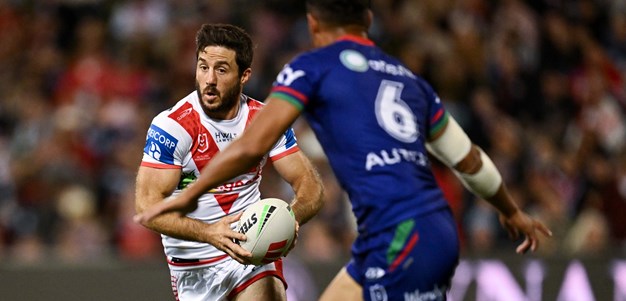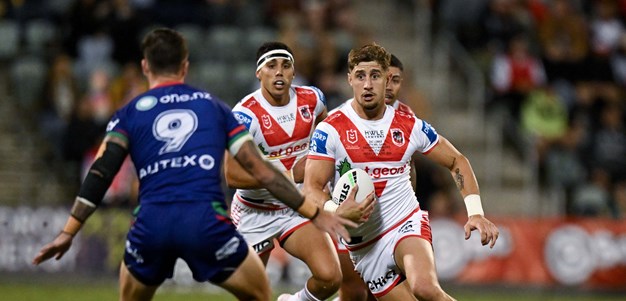You don’t have to be Nostradamus to figure out what new referees boss Daniel Anderson, colleague Tony Archer and co. are attempting to achieve with their 2013 NRL Laws and Interpretations.
After several seasons of concern from analysts, players and fans over the slowing down of the play-the-ball, Anderson and Archer have given their on-field officials the all-clear to limit the delaying tactics of ‘the wrestle’.
It’s clear from the penalty counts of the first two weeks of the 2013 season that the refs are cracking down big time on things like defenders having their hands on the ball and laying on the tackled player too long.
However, a look at the high number of times the refs’ whistles have been blown in anger over the opening fortnight suggests we could be in for a record number of penalties before the 2013 NRL season is finished.
Already the refs’ keenness to put more of the onus on the defender to clear the ruck quickly has led to a speeded-up pace of play. Defences have been shredded as guys like Rabbitohs hooker Issac Luke have torn them open, making huge inroads out of dummy-half as the tacklers struggle to reset their defensive line.
Stats Insider has delved through the numbers from 2012 and compared them to this season’s opening fortnight – the bottom line is a rise of almost two penalties per game on average, from 12.4 penalties in 2012 to 14.3 per game this year.
It’s a given among rugby league coaches and players that the refs will rule with an iron fist in the opening round every new season, as they lay down the law of the new interpretations. However, it’s also generally accepted that things ease off a little thereafter, a combination of the players falling into line and the refs rewarding the players for their willingness to conform.
That was certainly the case last season – Round 1 games in 2012 yielded a total of 104 penalties, with Round 2 dropping to a total of 95. At the end of the season things rounded out to an average of 9.6 penalties every 80 minutes at the conclusion of Round 26.
But this season the total number of penalties in Round 2 accelerated noticeably – from 108 in the first week to a whopping 121 last weekend.
And whereas the most penalties blown in the second round last year was 14, this year a staggering 22 penalties were blown in the Titans v Raiders clash on the Gold Coast (11 against each team).
Aren’t the players learning?
If this trend continues we should brace ourselves for a massive increase in the average number of penalties overall.
Is the heat a factor? Maybe – although you’d find it difficult to convince any fan that it’s hotter this season than at the same time in past seasons.
It seems to Stats Insider that players had better wake up to the fact that the refs are unlikely to back down in their quest to clean-up the ruck, and that they will continue to blow what some might have considered ‘harsh’ penalties last year.
More and more penalties will prove crucial to the outcome of matches – you just have to look at Adam Reynolds’ decisive penalty goal before halftime against the Sharks, which proved the difference between the sides.
Looking at the teams, it’s clear some are adapting to the new laws and interpretations of the rules quickly, and some are struggling.
Best performed are the Knights and Sharks (just 11 conceded each), closely followed by the Broncos (12) then the Dragons, Eels and Sea Eagles (13).
But by far the biggest offenders are the Wests Tigers (19), Raiders (18) and Roosters (17).
So what does referees boss Daniel Anderson think about the increased rate of penalties; after all, it wasn’t so long ago that a game of State of Origin with around four penalties all match was considered a desirable outcome.
“It’s fair to say that yes, some adjustments are going on week by week in regard to some of the new laws and interpretations but it’s not just one massive area, there are a lot of different areas that are contributing to it,” Anderson told NRL.com.
“Definitely the ruck and the hand off the ball – let’s call it the play-the-ball process and allowing the play-the-ball process to commence uninhibited – is probably the most significant adjustment that has been encountered for all teams. It’s been a number of years where different areas of the ruck have been adjudicated on but now we’re hopefully back to a simpler and cleaner ruck. Players are finding it a bit of a challenge to remove habits.”
Anderson said that the referees had been diligent in enforcing the new laws but expected penalty counts to drop as the heat waned and players grew more accustomed to the new rules.
“I’d hope so,” he said. “I’m not really sure but I think as the weather cools the players probably don’t feel the fatigue as much. The other thing is that obviously everyone beds in and understands the requirements.
“And the weather isn’t always dry so you get games, the night games in winter, that I guess aren’t played with the same frantic ball movement.”
Let’s wait and see what unfolds…



